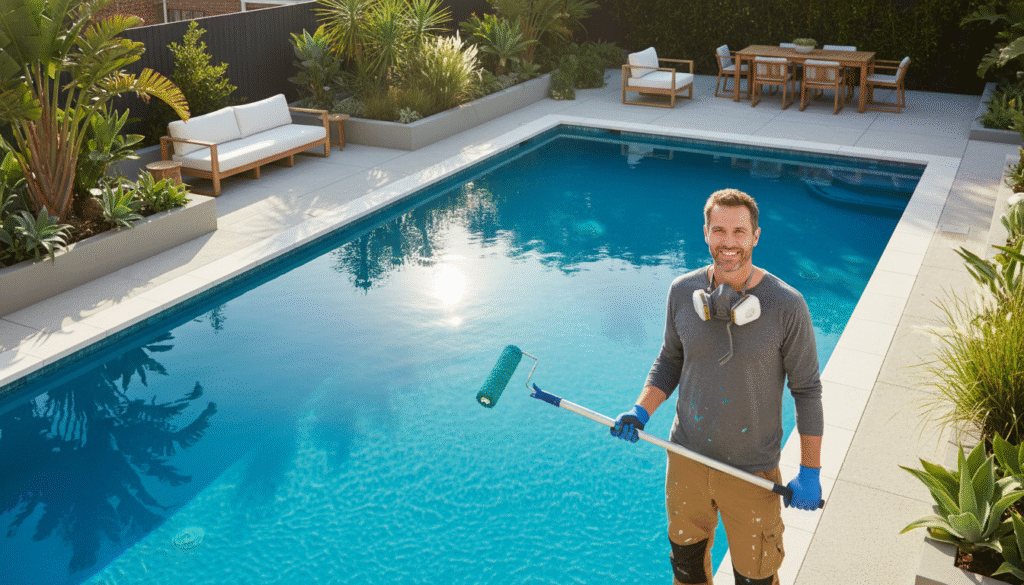I still remember the first time I saw a pool painted with epoxy that flawless mirror-like finish looked so fresh, it instantly transformed the entire backyard. If your swimming pool has lost its shine or started peeling, you don’t need to rebuild it. Sometimes, all it takes is a bit of patience, the right materials, and learning the art of painting swimming pool with epoxy paint the proper way.
Let’s dive into everything you need to know from prep work to curing so you can give your pool that professional, long-lasting glow.
Why Epoxy Paint Is a Game-Changer for Pools
Epoxy paint isn’t just any paint. It’s a two-part system made of resin and hardener that chemically bonds into a hard, waterproof coating. Once cured, it creates a smooth, high-gloss surface that’s resistant to chemicals, UV rays, and even rough use.
Key Benefits:
- Exceptional durability: It can last up to 10–15 years with proper maintenance.
- Waterproof seal: Prevents leaks and surface damage.
- Chemical resistance: Handles chlorine, pool salts, and cleaning agents.
- Aesthetic appeal: Offers a rich, glossy finish that makes your pool look brand-new.
Unlike standard pool paints that fade or peel after a couple of summers, epoxy forms a rock-solid barrier. But to get that result, surface prep and application techniques matter just as much as the product itself.
Preparing Your Pool: The Secret to a Flawless Finish
When it comes to painting swimming pool with epoxy paint, 70% of the success lies in preparation. A perfectly clean, dry, and roughened surface ensures the epoxy bonds like concrete.
Step 1: Inspect the Surface
Check for cracks, flaking paint, or chalky residue. If you’ve got an old painted pool, test a small area to see if the existing paint is epoxy or something else. Non-epoxy coatings need to be completely removed before recoating.
Step 2: Clean Thoroughly
Use a pressure washer or a strong detergent solution to remove grease, algae, or dirt. For stubborn stains or mineral deposits, an acid wash (diluted muriatic acid) works wonders — just rinse thoroughly afterward to neutralize any residue.
Step 3: Repair and Smooth
Fill cracks or holes with a pool patching compound or epoxy filler. Let it cure completely before sanding the surface smooth.
Step 4: Etch and Profile
Epoxy needs a rough texture to grip. If your pool surface is too smooth, use sanding tools or light acid etching to create a slightly coarse profile. Think of it like prepping a wall before painting — the rougher it is, the better it holds.
Step 5: Mask and Protect
Use painter’s tape to cover tiles, ladders, and pool lights. Clear the area of outdoor furniture and cover nearby plants or decking to avoid paint splatter.
Choosing the Right Epoxy Paint
There are different types of epoxy paints designed for various pool materials — concrete, plaster, or fiberglass. Make sure the one you pick matches your pool type.
1. 100% Solids Epoxy Paint
The most durable and chemical-resistant option. It doesn’t contain solvents and offers a thick, glossy finish — ideal for commercial or high-use pools.
2. Solvent-Based Epoxy Paint
Easier to apply and slightly more flexible but gives off stronger fumes. It’s a good balance between cost and performance.
3. Water-Based Epoxy Paint
Eco-friendly and easier for DIYers. While it’s not as long-lasting as 100% solids epoxy, it still provides great results for smaller or residential pools.
Applying Epoxy Paint: Step-by-Step Process
Now that your pool is prepped and your materials are ready, it’s time to start painting swimming pool with epoxy paint.
Step 1: Mix the Paint Properly
Epoxy paint comes in two parts Part A (resin) and Part B (hardener). Mix them in the exact ratio mentioned on the packaging. Stir gently to avoid air bubbles and let it sit for 5–10 minutes before applying.
💡 Tip: Once mixed, you usually have a 2–3 hour pot life. Don’t mix more than you can use within that window.
Step 2: Apply the Primer or First Coat
If your epoxy isn’t self-priming, start with a thin primer coat. Use a roller for wide areas and a brush for corners and steps. Work evenly, maintaining a wet edge to avoid lap marks.
Step 3: Apply the Second Coat
Wait for the first coat to dry (typically 12–24 hours), then apply the second coat in the opposite direction for an even finish. This layer seals the surface and enhances durability.
Step 4: Control the Environment
Ideal painting conditions are between 15–30°C (59–86°F) with low humidity. Avoid windy or dusty days — debris can ruin the finish.
Curing Time and Aftercare
Epoxy paint takes time to harden fully. You can usually walk on it after 24 hours, but don’t fill your pool with water for at least 5–7 days, depending on the brand and weather.
Curing Tips:
- Keep the surface free of dust and insects during the curing period.
- Avoid dragging tools or heavy items across the pool floor.
- If temperatures drop below 15°C, extend curing time by a few extra days.
Maintenance for Long-Term Results
Once your pool is filled and ready, proper maintenance keeps that new look for years.
- Maintain pH between 7.2 and 7.8 to prevent discoloration.
- Brush the pool weekly with a soft-bristle brush.
- Avoid using harsh metal scrapers or abrasive cleaners.
- Drain and inspect the pool every 2–3 years for touch-ups.
Regular care not only keeps the pool looking beautiful but also extends the lifespan of your epoxy coating.
Common Issues and How to Fix Them
Even with the best prep, things can go wrong. Here’s how to troubleshoot common epoxy painting issues.
| Problem | Cause | Solution |
|---|---|---|
| Peeling or Flaking | Moisture trapped or poor surface prep | Strip affected area, dry completely, reapply epoxy |
| Bubbling | Air entrapment during rolling | Roll slower, avoid painting in direct sun |
| Color Fading | UV exposure or cheap paint | Use UV-resistant topcoat |
| Sticky Surface | Incorrect mix ratio or humidity | Sand lightly, recoat properly |
Cost and Time Estimates
Painting a pool yourself can save thousands. On average:
- Material Cost: $300–$600 for an average-sized pool
- Tools & Supplies: $100–$150
- Time Required: 3–5 days for prep and painting, plus 7 days curing
If you hire professionals, expect around $1,500–$3,000, depending on the pool size and condition.
Safety First
Epoxy paint contains strong chemicals. Always take proper precautions:
- Wear gloves, a respirator mask, and goggles.
- Ensure good ventilation.
- Keep children and pets away during and after application.
- Avoid direct skin contact epoxy can cause irritation.
FAQs About Painting Swimming Pool with Epoxy Paint
Q1: Can I apply epoxy over old paint?
Only if the old paint is also epoxy and still bonded well. Otherwise, strip it off completely before repainting.
Q2: How long does epoxy pool paint last?
Typically 8–15 years, depending on maintenance, sun exposure, and water chemistry.
Q3: Can I do it myself or should I hire a pro?
You can DIY if you’re patient and follow directions carefully. For larger or commercial pools, professional application ensures longevity.
Q4: What’s the best temperature for painting?
Ideally between 15–30°C (59–86°F). Avoid extreme heat or humidity for best adhesion.
Q5: Is epoxy slippery?
It can be, especially when wet. You can mix a fine non-slip additive or silica sand into the topcoat for better grip.
Q6: How soon can I swim after painting?
Wait at least 7 full days before refilling and using the pool to ensure full curing.
Final Thoughts
If you’ve ever dreamed of giving your backyard a resort-like feel, this is your moment. Painting swimming pool with epoxy paint might sound intimidating, but once you understand the process, it’s incredibly rewarding.
The transformation is more than cosmetic it’s about bringing new life to an old space. A few days of effort, some smart prep work, and a can of epoxy paint can turn dull concrete into a sparkling blue oasis.
And when you finally dip into that crystal-clear water, reflecting your own hard work… trust me, it feels amazing.


